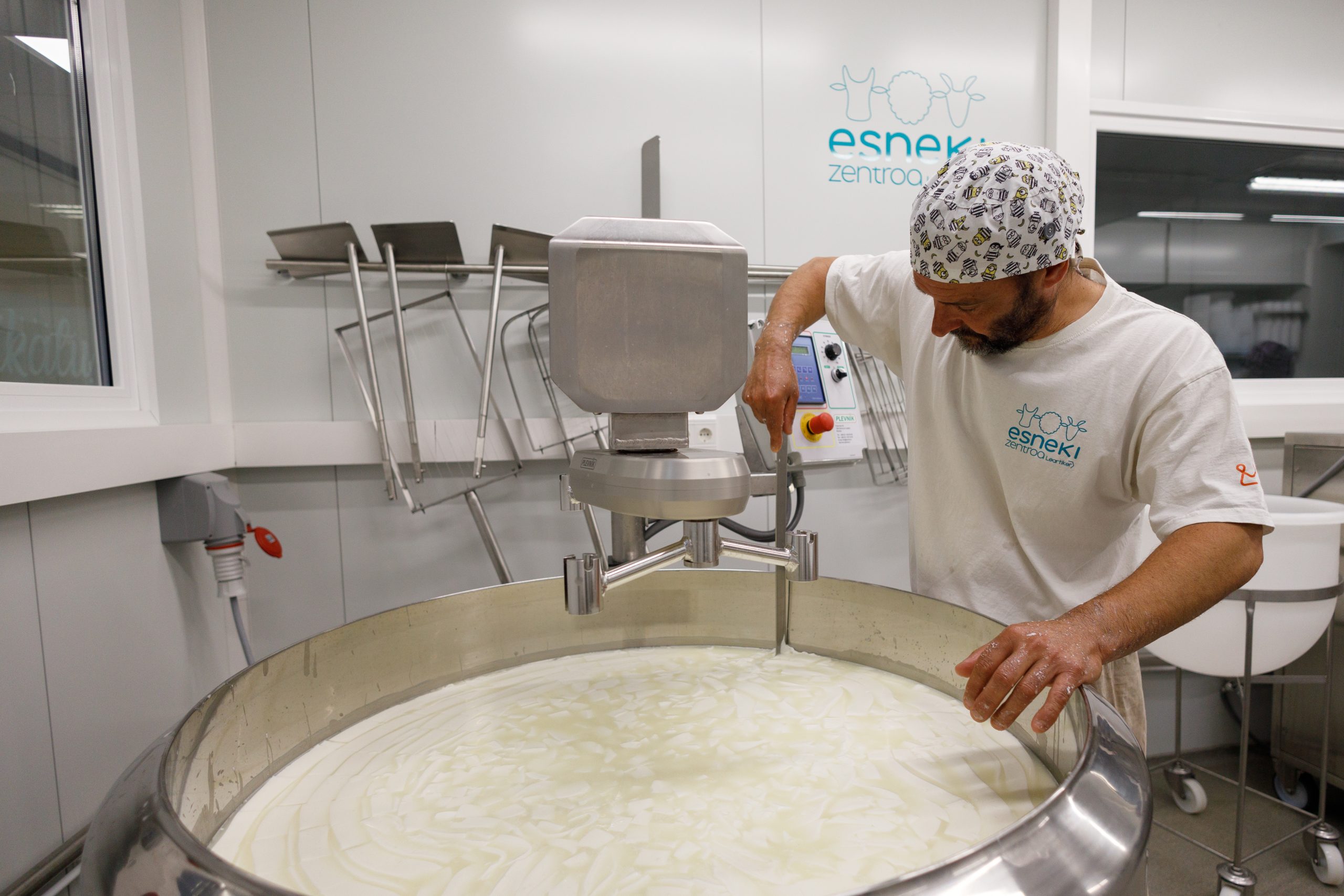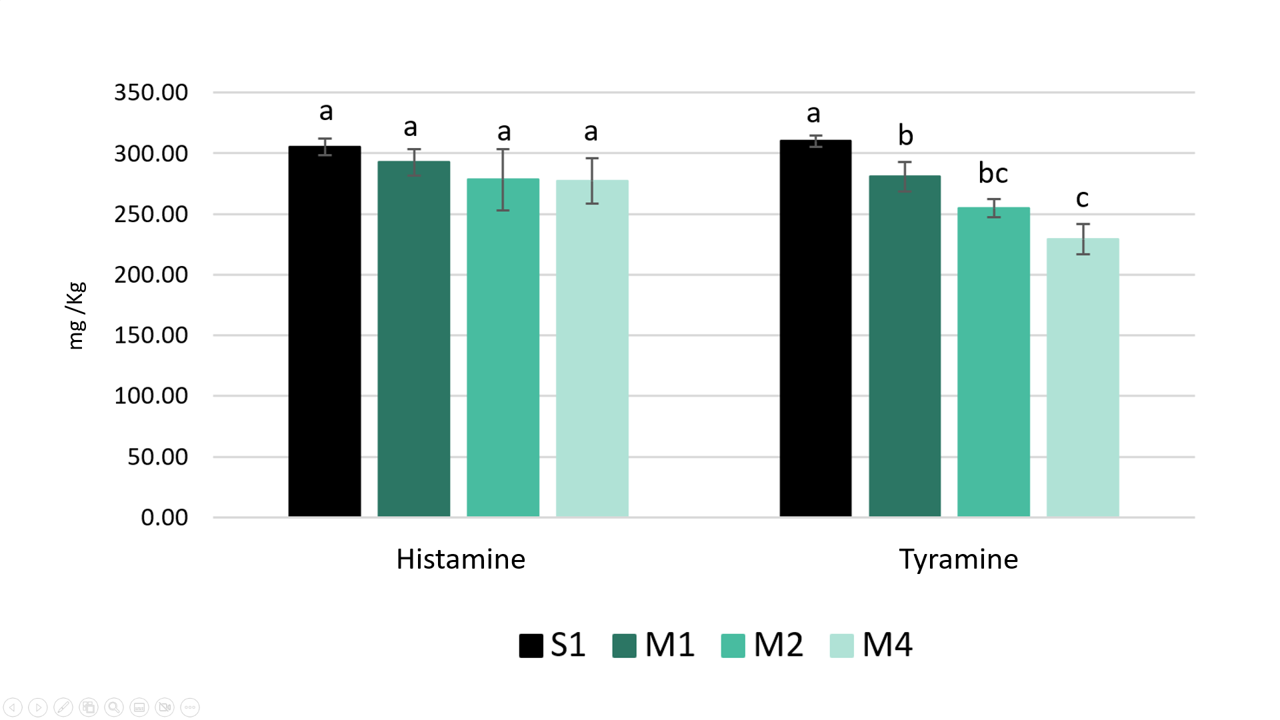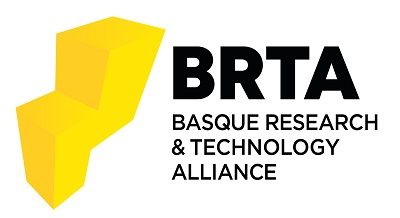Mitigating health risks through targeted microbial interventions
Author: Igor Baroja-Careaga, PhD, researcher in Molecular Biology, Esneki Zentroa (Leartiker S.COOP)
Biogenic amines (BAs) are nitrogenous compounds formed primarily by microbial decarboxylation of amino acids. In food products, they can accumulate to levels that pose health risks, including histamine poisoning and hypertensive crises due to tyramine ingestion 12. Fermented foods, particularly cheeses, are significant sources of BAs due to their complex microbial consortia and the metabolic activities occurring during ripening 3. While lactic acid bacteria contribute positively to flavor, texture, and preservation, some strains also possess decarboxylase activity, leading to BA accumulation and the health risks associated with it 45. Understanding microbial community dynamics at a genes level, has revolutionized food microbiology, allowing for precise identification of microbial capabilities and metabolic pathways 6.

In this study, BA-degrading capacities of different strains have been identified and selected manipulating microbial communities, to reduce BA accumulation in cheese while maintaining organoleptic quality.
Experimental Approach and Results
At Leartiker’s Dairy Center, a pilot plant and specialized laboratories enable controlled cheese production and in-depth monitoring of microbial and biochemical changes during ripening. In the present study, we confirmed that pressed cheeses commonly accumulate significant levels of biogenic amines (BAs), particularly tyramine and histamine, as a result of the metabolic activity of indigenous bacteria.
To address this issue, we tested the incorporation of Lactobacillus casei strains with documented BA-degrading capabilities into pressed cheese production. Specifically, we compared two strains from the Molecular Microbiology group of the IPLA-CSIC (4a and 5b) 7—selected for their BA-degrading activity, including Lacticaseibacillus casei harboring the mco gene encoding multicopper oxidase (a laccase enzyme involved in BA degradation)—with a widely used commercial L. casei strain.

Cheeses inoculated with these strains underwent standard ripening, followed by BA quantification using ultra-high performance liquid chromatography (UHPLC) 8. The results indicated that the IPLA-CSIC isolates effectively reduced BA levels, particularly tyramine (9.9% of histamine and 24.2% of tyramine). Interestingly, the commercial L. casei strain also contributed to BA reduction, suggesting that BA may be degraded by alternative mechanisms even in the absence of the mco gene (7.8% of histamine and 30% of tyramine).
No substantial differences were observed among the L. casei strains in terms of their overall ability to reduce BAs. However, among the tested strains, L. casei 5b achieved the greatest absolute reduction of histamine during cheese ripening (17.5%). In terms of tyramine degradation, all L. casei strains demonstrated effective reduction, with the commercial starter standing out due to a higher absolute reduction. Nevertheless, the differences observed were not statistically significant.
Conclusion and Future Perspectives
This study highlights the potential of targeted microbial selection in reducing BA content in cheese, offering a promising approach to enhance food safety without compromising product quality. The use of Lactobacillus casei strains, particularly those with known BA-degrading capabilities, resulted in significant reductions in tyramine and histamine during ripening. Notably, the effectiveness of the commercial strain—even in the absence of the mco gene—suggests that alternative degradation pathways may exist, or that competition with producer bacterial strains, potentially inhibiting their growth, could also play a meaningful role and warrants further investigation.
Moving forward, future studies should aim to elucidate the specific enzymatic pathways involved in BA degradation beyond multicopper oxidases, as well as explore synergistic effects when combining multiple strains. It will also be essential to validate these findings at an industrial scale, under varying milk sources, cheese types, and ripening conditions. In parallel, genomic and transcriptomic tools could assist in the development of microbial consortia tailored for both safety and sensory excellence.
Ultimately, the goal is to integrate precision microbial management strategies into dairy production workflows, enabling the creation of cheeses with consistently low—ideally undetectable 0 mg/kg —levels of BAs at the time of consumption, thereby contributing to safer and healthier fermented foods.
Acknowledgments
We gratefully acknowledge the Molecular Microbiology group from IPLA-CSIC (Instituto de Productos Lácteos de Asturias, Spain) for generously providing the bacterial strains used in this study. Their support has been essential for the development of this work.
The BRTA is a consortium that remains a step ahead of future socio-economic challenges worldwide and in the Basque Autonomous Community; it addresses them through research and technological development, thus projecting itself internationally. The BRTA centres collaborate to generate knowledge and transfer it to Basque society and industry so as to make them more innovative and competitive. The BRTA is an alliance of 17 R&D centres and cooperative research centres with the support of the Basque Government, the SPRI and the Chartered Provincial Councils of Araba, Bizkaia and Gipuzkoa.
References
- Del Rio, B., Fernandez, M., Redruello, B., Ladero, V., & Alvarez, M. A. (2024). New insights into the toxicological effects of dietary biogenic amines. Food Chemistry, 435, 137558. doi: 10.1016/j.foodchem.2023.137558 ↩
- Shalaby, A. R. (1996). Significance of biogenic amines to food safety and human health. Food Research International, 29(7), 675–690. doi: 10.1016/S0963-9969(96)00066-X ↩
- Linares, D. M., Del Río, B., Ladero, V., Martínez, N., Fernández, M., Martín, M. C., & Álvarez, M. A. (2012). Factors Influencing Biogenic Amines Accumulation in Dairy Products. Frontiers in Microbiology, 3. doi: 10.3389/fmicb.2012.00180 ↩
- Bravo-Lamas, L., Baroja-Careaga, I., Olañeta-Jainaga, A., & Sarasua, M. (2025). Evaluating bacterial contributions to biogenic amines levels in commercial cheeses. Food Control, 175, 111334. doi: 10.1016/j.foodcont.2025.111334 ↩
- EFSA. (2011). Scientific Opinion on risk-based control of biogenic amine formation in fermented foods. EFSA Journal, 2011;9(10):2393. doi: 10.2903/j.efsa.2011.2393 ↩
- Kergourlay, G., Taminiau, B., Daube, G., & Champomier Vergès, M.-C. (2015). Metagenomic insights into the dynamics of microbial communities in food. International Journal of Food Microbiology, 213, 31–39. doi: 10.1016/j.ijfoodmicro.2015.09.010 ↩
- Herrero-Fresno, A., Martínez, N., Sánchez-Llana, E., Díaz, M., Fernández, M., Martin, M. C., Ladero, V., & Alvarez, M. A. (2012). Lactobacillus casei strains isolated from cheese reduce biogenic amine accumulation in an experimental model. International Journal of Food Microbiology, 157(2), 297–304. doi: 10.1016/j.ijfoodmicro.2012.06.002 ↩
- Redruello, B., Ladero, V., Cuesta, I., Álvarez-Buylla, J. R., Martín, M. C., Fernández, M., & Alvarez, M. A. (2013). A fast, reliable, ultra-high performance liquid chromatography method for the simultaneous determination of amino acids, biogenic amines and ammonium ions in cheese, using diethyl ethoxymethylenemalonate as a derivatising agent. Food Chemistry, 139(1), 1029–1035. doi: 10.1016/j.foodchem.2013.01.071 ↩
